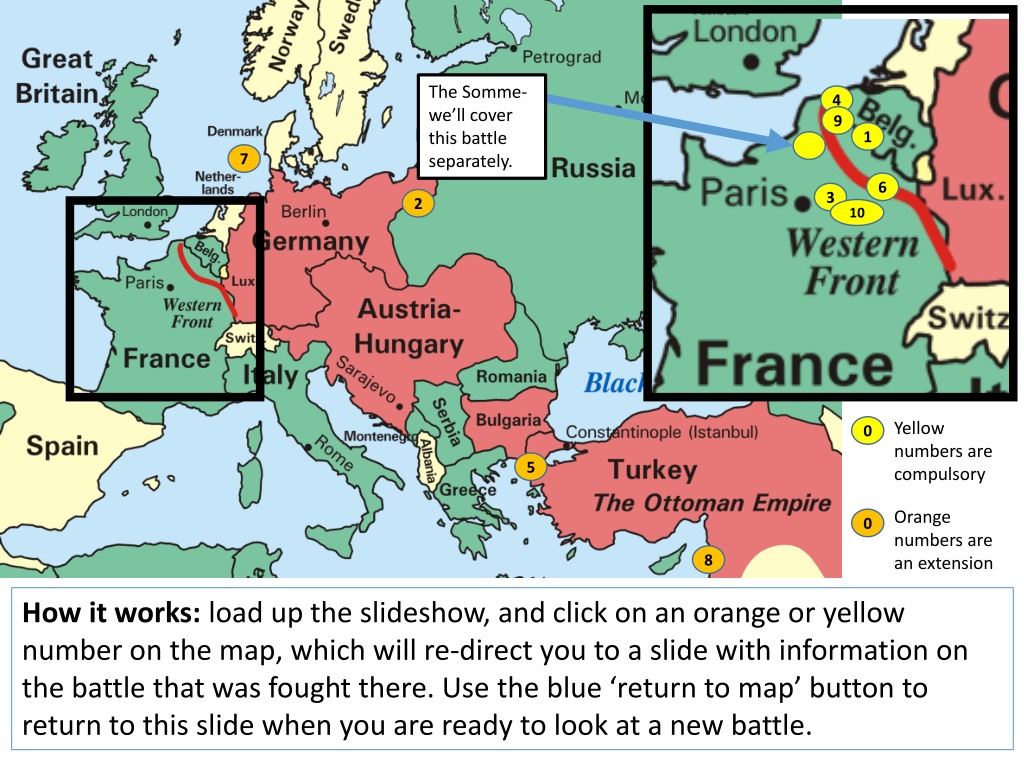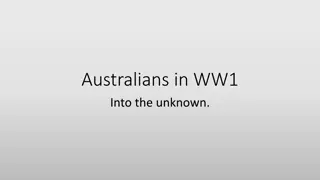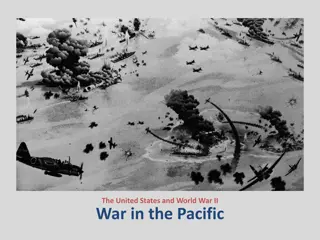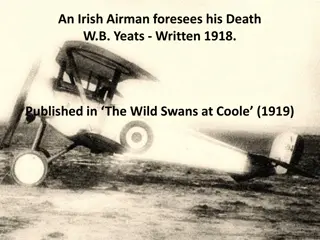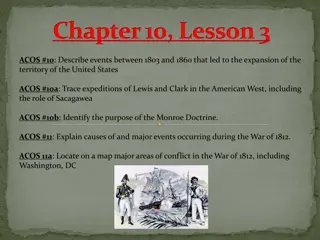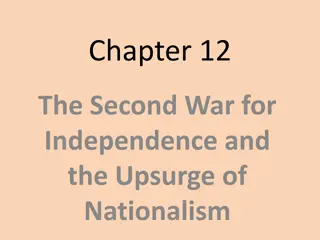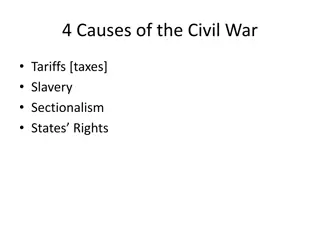Major Battles of World War I in 1914
The Battle of Mons saw the British Expeditionary Force confront the advancing German Army in Belgium, leading to a strategic retreat. In the Battle of Tannenberg, the Russian Second Army suffered a devastating defeat at the hands of the Germans. The First Battle of the Marne marked a crucial turning point on the Western Front as the Allies successfully repelled the German advance towards Paris.
Download Presentation

Please find below an Image/Link to download the presentation.
The content on the website is provided AS IS for your information and personal use only. It may not be sold, licensed, or shared on other websites without obtaining consent from the author.If you encounter any issues during the download, it is possible that the publisher has removed the file from their server.
You are allowed to download the files provided on this website for personal or commercial use, subject to the condition that they are used lawfully. All files are the property of their respective owners.
The content on the website is provided AS IS for your information and personal use only. It may not be sold, licensed, or shared on other websites without obtaining consent from the author.
E N D
Presentation Transcript
The Somme- we ll cover this battle separately. 4 4 9 9 1 1 7 7 6 6 3 2 3 2 10 10 Yellow numbers are compulsory 0 5 5 Orange numbers are an extension 0 8 8 How it works: load up the slideshow, and click on an orange or yellow number on the map, which will re-direct you to a slide with information on the battle that was fought there. Use the blue return to map button to return to this slide when you are ready to look at a new battle.
Return to Map The Battle of Mons, 23rd August 1914 Return to Map The British Expeditionary Force (BEF) arrived in France on 14th August, 1914. On their way to meet the French Army, the 70,000-strong BEF met the advancing German Army (of 150,000 soldiers) at Mons in Belgium. The British Commander, Sir John French, deployed the British infantry corps on a 40km front. The cavalry division was kept in reserve. BEF attempt to stop German invasion. To stop the Germans advancing in to France, orders were given to a group of Royal Fusiliers to destroy the bridges over the Mons-Conde Canal. The men came under heavy German fire and five men won the Victoria Cross for their work. On the morning of 23rd August, the German general Alexander von Kluck and the German army attacked the British positions. The German First Army suffered heavy losses from British rifle fire, yet the outnumbered BEF were forced to retreat. The Germans drove the BEF and French armies before them almost to Paris, before being stopped at the Battle of the Marne. The retreat from Mons to the Marne.
The Battle of Tannenburg, August 1914 Return to Map Return to Map On the Eastern Front, between Germany and Russia, General Samsonov was given command of the Russian Second Army. He advanced slowly into the south western corner of Germany, with the intention of linking up with another Russian army advancing from the north east. The commander of the German Eighth Army, General Prittwitz, was dismissed for ordering a retreat when faced with the Russian Second Army. German Generals Hindenburg and Ludendorff were then sent forward to meet Samsonov's advancing troops. Hindenberg observes the battle. They made contact on 22nd August, 1914. For six days, the Russians, with their superior numbers, had some success. Yet, by 29th August, Samsanov's army was surrounded. Samsonov attempted to retreat, but most of his troops were slaughtered or captured. Only 10,000 of the 150,000 Russian soldiers escaped. Shocked by the disaster, Samsanov committed suicide. The Germans, who had lost 20,000 men, were able to take over 92,000 Russian prisoners. In Britain, news of the Russian defeat at Tannenberg was kept from the public. The Russian Second Army surrenders.
Return to Map First Battle of the Marne, 6-10th September 1914 Return to Map At the end of August 1914, on the Western Front, the German Army was sweeping south towards Paris. The French Fifth and Sixth Armies, and British Expeditionary Force (BEF), were in retreat. General von Kluck, commander of the German First Army, was ordered to encircle Paris. The French retreated to a line south-east of Paris, and then planned to attack the German First Army on 6th September. The commander of the BEF, Sir John French, agreed to join the attack. General von Kluck wheeled his entire force to meet the attack, opening a 50km gap between his own forces and the German Second Army. The BEF and French Fifth Army advanced into the gap that had been created, splitting the two German armies. For the next three days, German forces were unable to break through the Allied lines. At one stage, the French Sixth Army came close to defeat and were only saved by the use of Paris taxis to rush 6,000 reserve troops to the front line. On 9th September, the Germans retreated. The British and French forces were now able to cross the River Marne. Yet progress was slow and the German armies regrouped Map of Battle Positions by 10th September, the battle was over. The French and Germans both had around 250,000 casualties. The BEF lost 12,733 men. The French and British forces were able to prevent the German plan for a swift and decisive victory over France. Yet the German Army was not beaten and its successful retreat ended all hope of a short war.
Return to Map The First Battle of Ypres, Oct-Nov 1914 Return to Map Ypres, a medieval town in Belgium, was taken by the Germans at the beginning of the war. The town held a strategic position as it was close to channel ports vital for supplies. But, by early October, the British Expeditionary Force (BEF) re-captured the town. The first major German attempt to regain Ypres took place on 15th October. Experienced BEF riflemen held their positions, but suffered heavy losses. The BEF in Ypres German attacks took place for the next four weeks. The arrival of the French Army ensured that the line was held. With the weather deteriorating, the Germans decided to abandon the Ypres offensive on the 22nd November. About 135,000 Germans were killed or badly wounded. The BEF lost around 75,000 men, and was effectively destroyed as a professional army. There were two more major battles at Ypres: the Second Battle of Ypres (April-May, 1915) and Passchendaele (July-October, 1917). Sikh army fighting for the British empire at Ypres
Gallipoli Campaign The Gallipoli Campaign, 1915 On 19th February, 1915, British ships attacked Turkish forts, in the aim of securing a sea route to the Russian Empire from the Mediterranean, through a waterway called the Dardanelles. The assault started with long range bombardment, followed by heavy fire at closer range. The outer forts were abandoned by the Turks. Yet further advance up into the straits was impossible - the Turkish forts were too far away. Winston Churchill, First Lord of the Admiralty, became impatient about the slow progress that Admiral Carden was making, and Carden was sent home. He was replaced by Vice-Admiral Sir John de Robeck, who immediately ordered the Allied fleet to advance up the Dardanelles Straits. Return to Map Return to Map Outcome: Overall, about 480,000 Allied troops from the British empire took part in the Gallipoli campaign. The British had 205,000 casualties (43,000 killed). Turkish casualties are estimated at 250,000 (65,000 killed). On 18th March, eighteen battleships entered the straits. At first they made good progress, until a ship called Bouvet struck a mine and disappeared in a cloud of smoke. Soon after, two more ships, (Irresistible and Ocean) hit mines. Churchill was told that Gallipoli could not be taken without the army. Plans were made for full-scale army landings. Lord Kitchener, the war minister, was informed that 150,000 men would be needed, but sent only half that number. Attempts to sweep across the peninsula ended in failure, despite sending thousands more reinforcements.
Return to Map The Battle of Verdun, Dec 1914-Dec 1916 Return to Map Verdun was a fortified French town, 200km east of Paris, and had been the strongest point of defence in pre-war France. In December 1915, the Germans decided to attack it, hoping to "bleed the French army white . A million German troops, led by Prince Wilhelm, attacked about 200,000 French defenders on 21st February 1916. In the following days, the French were forced to retreat to their second line of trenches, and then third. Verdun was the longest battle of WWI. The French Army lost about 550,000 men at Verdun. It is estimated that the German Army suffered 434,000 casualties. General Petain was then appointed commander of the Verdun sector. He said there would be no more withdrawals. He arranged for every spare soldier to be transported to this part of the Western Front. Of the 330 infantry regiments of the French Army, 259 eventually fought at Verdun. The German advance was brought to a halt at the end of February. On the 6th March, the German Fifth Army launched a new attack, and these continued throughout the summer and early autumn. However, the scale of the German attacks were reduced by the need to transfer troops to defend their front-line at the Somme. The French then counter-attacked.
The Outcome Return to Map The Battle of Jutland, May 1916 Return to Map The German Navy claimed victory based on the number of ships destroyed: the British lost 3 battleships, 3 cruisers and 8 destroyers (6,100 casualties); the German Navy lost 1 battleship, 1 battlecruiser, 4 cruisers and 3 destroyers (2,550 casualties). Jellicoe was criticised for being over-cautious, but he argued that it was vitally important to protect the size of his Grand Fleet. Indeed, Jellicoe said on 2nd June that the Grand Fleet was ready for further action, whereas the German High Seas Fleet had to be reconstructed and was never in the position to risk another major North Sea confrontation. The fleet of the British Navy had been designed to fight a huge, decisive battle with the enemy. So attempts were made to draw the smaller German Navy into the North Sea for such a battle. German Admiral von Pohl resisted, but in February 1916, he was replaced by the more aggressive Admiral von Scheer. In May 1916, Scheer decided he would take on the British Navy. He ordered 40 ships to begin a sweep along the Danish coast. Admiral John Jellicoe gave instructions for the British Grand Fleet to put to sea. Without aircraft, Jellicoe and Scheer sent out scouting cruisers to locate the position of the enemy. The Grand Fleet opened fire immediately. Scheer, recognising his danger, ordered his ships to turn north. British Admiral Jellicoe, fearing that Scheer was trying to lead the Grand Fleet into a submarine trap or minefield, didn t follow. Instead he headed south, hoping to intercept Scheer's homeward journey. At 19.10, the fleets made contact again. Scheer ordered Admiral Hipper's battleships to charge the Grand Fleet, while his other ships turned away. After 20 minutes, Hipper headed home too. Again unwilling to follow the same route as the German ships, Sir John Jellicoe headed south-west and managed to intercept Hipper at 20.15. German ship Lutzow was sunk and Seydlitz and Derfflinger were badly damaged, before the British decided once again not to follow the retreating German ships.
Return to Map Return to Map The Battle of Gaza, Summer/Autumn 1917 Following the evacuation of Gallipoli in November 1915, the ANZAC (Australian and New Zealand Army Corps) was relocated to Egypt in December 1916. The ANZAC mounted division led British forces towards Gaza, yet General Kressenstein, commander of the Turkish Force, occupied the main coastal fortresses and blocked the route. Turks defend Gaza Kressenstein had 18,000 men but was outnumbered 2 to 1 by British General Dobell s forces. Dobell massed the main bulk of his men 8km from Gaza. Undetected in a dense sea fog, Dobell's cavalry was able to cut off the town's rear on the 26th March, yet a Turkish counterattack and water shortages forced Dobell to order his men to retreat. General Dobell lost 4,000 men against 2,400 Turkish and German casualties. In June 1917, General Allenby was transferred to Palestine. His victory in Gaza was secured using bombardment by ships offshore and effective use of cavalry. In the weeks that followed, the Turks retreated 75 miles and on 9th December the allied forces took Jerusalem. Although a clear victory, between October and December, 1917, the British and Empire forces lost 19,702 men during the campaign in the Middle East. Allenby enters Jerusalem
Return to Map Battle of Passchendaele (Third Battle of Ypres), 1917 Return to Map This battle took place between July and November, 1917. General Haig was convinced that the German army was close to collapse and made plans for a major offensive to break them. The opening attack involved a 10-day preliminary bombardment, with 3,000 guns firing 4.25 million shells. The offensive then started at Ypres at 3.50am on 31st July. Soon, heavy rain turned the landscape into a swamp. The situation was made worse by the fact that the British heavy bombardment had destroyed the drainage system. The use of tanks became impossible, and the Germans held on. Eventually, Haig called off the attack, but resumed it on 26th September, which enabled British forces to take possession of the ridge east of Ypres. Despite the return of rain, Haig ordered further attacks, which were unsuccessful. On 6th November the village of Passchendaele was finally taken. The offensive cost the BEF about 310,000 casualties. Haig was criticised for continuing the attack long after the operation had lost any real strategic value. Images of Ypres in 1917 "The living conditions in our camp were sordid beyond belief. The cookhouse was flooded, and most of the food was uneatable. There was nothing but sodden biscuits and cold stew. Robert Sherriff, British soldier
Return to Map Return to Map Second Battle of the Marne, July 1918 The first Battle of the Marne in September 1914 had stopped the Germans from inflicting a swift and decisive victory over France. The second major battle close to the River Marne took place in summer 1918. During their Spring Offensive, the German Army had again reached the Marne. The French Army was in poor shape and the Commander-in-Chief, Petain, knew that the British were busy dealing with a German offensive elsewhere. Finally, Haig agreed to send Petain four BEF divisions, and two divisions of the recently arrived US Army were also available. Over 85,000 American soldiers took part in the battle. African American troops fighting in WWI Outcome: Allied casualties during the 2nd Battle of the Marne were heavy: French (95,000), British (13,000) and United States (12,000). It is estimated that the German Army suffered an estimated 168,000 casualties. The battle marked the last real attempt by the Central Powers (or Triple Alliance ) to win the First World War. The attack on the Marne was launched by General Ludendorff on 15th July, yet the Germans failed to break through and the Allies counterattacked. On 20th July, the Germans began to withdraw. By the 3rd August they were back to where they were when they started the Spring Offensive in March.
